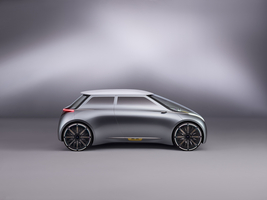|
Send this page to a friend! Fill in the form bellow | ||
news
autoviva2016-06-20 16:49:15
0comments
Mini celebrates BMW's centenary with a concept
Vision Next 100 shows design and technological paths thath might be taken in the future
The Vision Next 100 is a concept equipped with the latest autonomous driving technology and digital intelligence
© photo courtesy of: MINI (BMW)
Mini MINI (BMW)Germany, 2000 > present15 models
MINI (BMW)Germany, 2000 > present15 models
2211 photos
7 videos
bet in an advanced technology concept to celebrate the centenary of mother house BMW. The four-seater shows a cleaner design language that might be used in the future by the brand. The BMW BMWGermany, 1918 > present87 models
BMWGermany, 1918 > present87 models
8471 photos
43 videos
asked Mini to create the vehicle taking into account an increasingly digital and interconnected world.
 MINI (BMW)Germany, 2000 > present15 models
MINI (BMW)Germany, 2000 > present15 models2211 photos
7 videos
bet in an advanced technology concept to celebrate the centenary of mother house BMW. The four-seater shows a cleaner design language that might be used in the future by the brand. The BMW
 BMWGermany, 1918 > present87 models
BMWGermany, 1918 > present87 models8471 photos
43 videos
asked Mini to create the vehicle taking into account an increasingly digital and interconnected world.
The Vision Next 100 MINI (BMW) Mini Vision Ne...Germany, 2016 > 2016 is a concept equipped with the latest autonomous driving technology and digital intelligence. For example, the vehicle catch its driver in a chosen location and also adapt the vehicle according to his preferences before it even gets to the site. This possibility goes towards the increasing propensity and perhaps even growing need for car sharing. According to Mini, in the future the autonomous driving technology will allow the vehicle to travel without an occupant to a charging or wash station, a garage, or even to catch the next commuter.
MINI (BMW) Mini Vision Ne...Germany, 2016 > 2016 is a concept equipped with the latest autonomous driving technology and digital intelligence. For example, the vehicle catch its driver in a chosen location and also adapt the vehicle according to his preferences before it even gets to the site. This possibility goes towards the increasing propensity and perhaps even growing need for car sharing. According to Mini, in the future the autonomous driving technology will allow the vehicle to travel without an occupant to a charging or wash station, a garage, or even to catch the next commuter.
 MINI (BMW) Mini Vision Ne...Germany, 2016 > 2016 is a concept equipped with the latest autonomous driving technology and digital intelligence. For example, the vehicle catch its driver in a chosen location and also adapt the vehicle according to his preferences before it even gets to the site. This possibility goes towards the increasing propensity and perhaps even growing need for car sharing. According to Mini, in the future the autonomous driving technology will allow the vehicle to travel without an occupant to a charging or wash station, a garage, or even to catch the next commuter.
MINI (BMW) Mini Vision Ne...Germany, 2016 > 2016 is a concept equipped with the latest autonomous driving technology and digital intelligence. For example, the vehicle catch its driver in a chosen location and also adapt the vehicle according to his preferences before it even gets to the site. This possibility goes towards the increasing propensity and perhaps even growing need for car sharing. According to Mini, in the future the autonomous driving technology will allow the vehicle to travel without an occupant to a charging or wash station, a garage, or even to catch the next commuter.
In terms of the concept's design it features a boxy shape without hood, but with an elongates windscreen. The front features a reinterpretation of the classic Mini hexagonal grille with round headlights. Other features of the concept's design include the LED lights placed in the front ends of the fenders, the prominent wheel arches, the floating roof and the rear LED lights placed full-width over a discrete spoiler.
With 3620mm, the Vision Next 100 is 560mm longer than the original Mini, but 270mm shorter than the current Mini hatchback. These dimensions were a deliberate choice from the brand that did not want to create a vehicle that departed too much from the 1959 original Mini.
Inside the Mini bet on simplicity and functionality. The vehicle keeps the steering wheel and places it in a central position when traveling in autonomous mode. To facilitate the entry and exit of passengers on both sides of the vehicle the interior of the Vision Next 100 features a front bench with a full-width foot zone.
Inspired by the circular instrument panel of the original Mini, the centerpiece of the interior of the concept, called the Cooperizer, allows the driver to choose different settings and access features of the entertainment and communication systems.
Encyclopedia |
Contribute
publish your news and scoops
more about MINI (BMW)

MINI reveals 2017 Countryman JCW - 2017.01.19

Mini Clubman John Cooper Works revealed - 2016.09.22

Mini reveals Clubman ALL4 - 2016.01.27
latest news

Hamilton just nine points away from title renewal - 2017.10.23

Ferrari replaces California T by Portofino - 2017.08.29

Four reasons why to love the new Porsche 911 GT3 - 2017.05.05
Newsletter
ceroacero | ogol | zerozero.pt | playmakerstats | calciozz | leballonrond | fussballzz | voetbalzz | zerozero.com.ar | soccerzz | zerozero.com.mx | home | about | legal | advertise | FAQ | contact us | editorial team |
© autoviva | memória visual | all rights reserved







